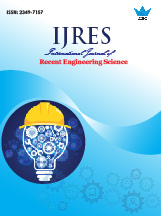Superhydrophobic / Superoleophilic Cotton Fabric for Oil / Water Separation
Citation
MLA Style :Than Than Aye, Cai-Hong Shen, Phyu Phyu Win "Superhydrophobic / Superoleophilic Cotton Fabric for Oil / Water Separation" International Journal of Recent Engineering Science 6.3(2019):26-30.
APA Style :Than Than Aye, Cai-Hong Shen, Phyu Phyu Win, Superhydrophobic / Superoleophilic Cotton Fabric for Oil / Water Separation. International Journal of Recent Engineering Science, 6(3),26-30.
Abstract
Super-hydrophobic and super-oleophilic Textile oil-water separator was successfully prepared by a coating of modified silane solution on the textile cloth surface by a spray coating method. To prepare superhydrophobic cotton oil water separator, raw cotton cloth was treated with detergent, cleaned with water, and dried in air. The formation of an oil-water separator by modified silane solution for superhydrophobicity was confirmed by dropping on the surface of modified cotton with a colour solution and investigated the wetting behavior and absorption capacity of probing liquids on the superhydrophobic cotton by the water contact angle. The silane coated cotton showed higher water repellent activity and higher absorption capacity of oil than raw cotton with 146.2?C of water contact angle and absorption capacity of two kinds of probing liquids were greater than raw cotton fabric.
Reference
[1] T. Dalton and D. Jin, "Extent and frequency of vessel oil spills in US marine protected areas," Marine Pollution Bulletin, vol. 60, no. 11, pp. 1939–1945, 2010.
[2] M. Santander, R. T. Rodrigues, and J. Rubio, "Modified jet flotation in oil (petroleum) emulsion/water separations," Colloids and Surfaces A: Physicochemical and Engineering Aspects, vol. 375, no. 1–3, pp. 237–244, 2011.
[3] E. B. Barbier, D. Moreno-Mateos, A. D. Rogers, et al., "Ecology: protect the deep sea," Nature, vol. 505, no. 7484, pp. 475–477, 2014.
[4] Z. Xue, Y. Cao, N. Liu, L. Feng, and L. Jiang, "Special wettable materials for oil/water separation," Journal of Materials Chemistry A, vol. 2, no. 8, pp. 2445–2460, 2014.
[5] J. V. Mullin and M. A. Champ "Introduction/ overview to in situ burning of oil spills," Spill Science & Technology Bulletin, vol. 8, no. 4, pp. 323–330, 2003.
[6] S. A. Shedid, J. H. Abou-Kassem, and A. Y. Zekri, "Mechanical cleaning of oil spills in seawater using circular conduits," Energy Sources, vol. 27, no. 13, pp. 1257–1268, 2005.
[7] F. Zhang, W. B. Zhang, Z. Shi, D. Wang, J. Jin, and L. Jiang, "Nanowire-haired inorganic membranes with super hydrophilicity and underwater ultralow adhesive superoleophobicity for highefficiency oil/water separation," Advanced Materials, vol. 25, no. 30, pp. 4192–4198, 2013.
[8] X. Yue,T. Zhang, D. Yang et al., "*e synthesis of hierarchical porous Al2O3/acrylic resin composites as durable, efficient and recyclable absorbents for oil/water separation," Chemical Engineering Journal, vol. 309, pp. 522–531, 2017.
[9] K. Li, X. Zeng, H. Li, and X. Lai, "Facile fabrication of a robust superhydrophobic/superoleophilic sponge for selective oil absorption from oily water," RSC Advances, vol. 4, no. 45, pp. 23861–23868, 2014.
[10] Du C, Wang J, Chen Z, Chen D. Durable superhydrophobic and superoleophilic filter paper for oil–water separation prepared by a colloidal deposition method. Applied Surface Science. 2014;313: 304-10.
[11] Abbasi M, Salahi A, Mirfendereski M, Mohammadi T, Pak A. Dimensional analysis of permeation flux for microfiltration of oily wastewaters using mullite ceramic membranes, Desalination. 2010; 252(1–3):113-9.
[12] Su C, Xu Y, Zhang W, Liu Y, Li J. Porous ceramic membrane with superhydrophobic and superoleophilic surface for reclaiming oil from oily water. Applied Surface Science. 2012;258(7):2319- 23.
[13] Kharisov BI, Dias HVR, Kharissova OV. Nanotechnology-based remediation of petroleum impurities from water. Journal of Petroleum Science and Engineering. 2014;122:705-18.
[14] Mohammed RR, Ibrahim IAR, Taha AH, McKay G. Waste lubricating oil treatment by extraction and adsorption. Chemical Engineering Journal. 2013; 220: 343-51.
[15] Khemakhem M, Khemakhem S, Ben Amar R. Emulsion separation using hydrophobic grafted ceramic membranes by. Colloids and Surfaces A: Physicochemical and Engineering Aspects. 2013;436:402-7.
[16] Yang H, Pi P, Cai Z-Q, Wen X, Wang X, Cheng J, et al. Facile preparation of superhydrophobic and super-oleophilic silica film on stainless steel mesh via sol–gel process. Applied Surface Science. 2010; 256(13):4095-102.
[17] Su C, Xu Y, Zhang W, Liu Y, Li J. Porous ceramic membrane with superhydrophobic and superoleophilic surface for reclaiming oil from oily water.Applied Surface Science. 2012;258(7):2319- 23.
[18] Wang L, Yang S, Wang J, Wang C, Chen L. Fabrication of superhydrophobic TPU film for oil–water separation based on electrospinning route.Materials Letters. 2011;65(5):869-72.
[19] Lin J, Shang Y, Ding B, Yang J, Yu J, Al-Deyab SS. Nanoporous polystyrene fibers for oil spill cleanup. Marine Pollution Bulletin. 2012;64(2):347-52.
[20] Shutao W, Yanlin S, Lei J. Microscale and nanoscale hierarchical structured mesh films with superhydrophobic and superoleophilic properties induced by long-chain fatty acids.Nanotechnology. 2007;18(1):015103.
[21] Ma W, Guo Z, Zhao J, Yu Q, Wang F, Han J, et al. Polyimide/cellulose acetate core/shell electrospun fibrous membranes for oil-water separation, Separation and Purification Technology. 2017; 177 :71-85.
[22] Briscoe BJ, Luckham PF, Jayarajah JN, Akeju T. Separation of emulsions using fibrous fabric. Colloids and Surfaces A: Physicochemical and Engineering Aspects. 2000;163(2–3):151- 64.
[23] Cambiella Á, Ortea E, Ríos G, Benito JM, Pazos C, Coca J. Treatment of oil-in-water emulsions: Performance of a sawdust bed filter. Journal of Hazardous Materials. 2006; 131(1–3):195-9.
Keywords
Textile cloth, superhydrophobic, a spray method, FTIR, probing liquid.


